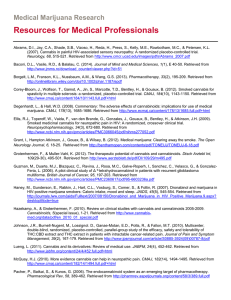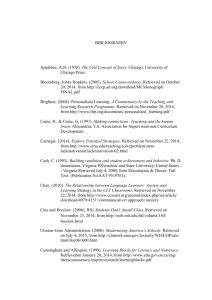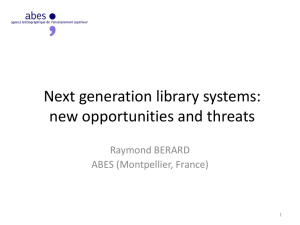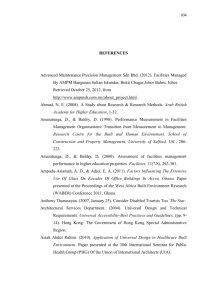Digital Library Curriculum Development 7-g: Personalization (Draft, 10/09/2009) 1. Module name: Personalization
advertisement
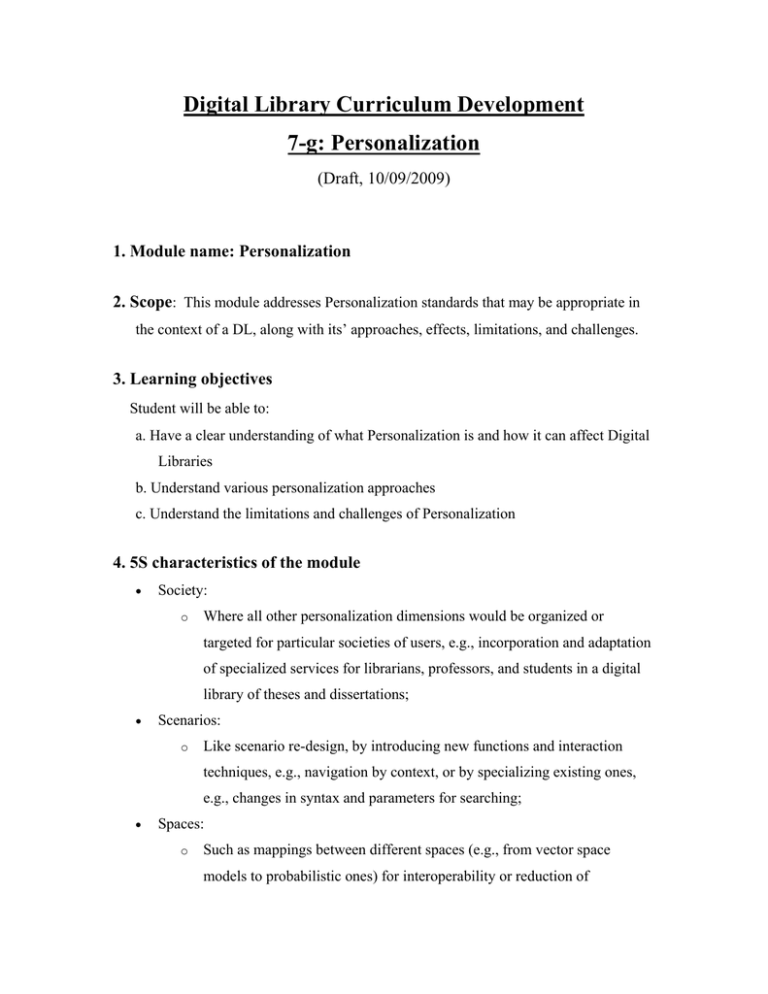
Digital Library Curriculum Development 7-g: Personalization (Draft, 10/09/2009) 1. Module name: Personalization 2. Scope: This module addresses Personalization standards that may be appropriate in the context of a DL, along with its’ approaches, effects, limitations, and challenges. 3. Learning objectives Student will be able to: a. Have a clear understanding of what Personalization is and how it can affect Digital Libraries b. Understand various personalization approaches c. Understand the limitations and challenges of Personalization 4. 5S characteristics of the module • Society: o Where all other personalization dimensions would be organized or targeted for particular societies of users, e.g., incorporation and adaptation of specialized services for librarians, professors, and students in a digital library of theses and dissertations; • Scenarios: o Like scenario re-design, by introducing new functions and interaction techniques, e.g., navigation by context, or by specializing existing ones, e.g., changes in syntax and parameters for searching; • Spaces: o Such as mappings between different spaces (e.g., from vector space models to probabilistic ones) for interoperability or reduction of dimensionality for providing better search services (e.g., with Latent Semantic Indexing (LSI)); • Structures: o Including restructuring, reduction, or other transformations over classification systems, ontologies, internal structures of documents, etc; • Stream: o Which could include, in the case of textual streams, translations of language and conversion of encodings, or, in the case of multimedia data, possible conversions between formats according to a user's platform; 5. Level of effort required (in-class and out-of-class time required for students) a. In class: 1.25 hours b. Outside of class: 2-3 hours for readings 6. Relationships with other modules (flow between modules) a. Module 6-d (Interaction design, usability assessment) i. b. Personalization could affect the usability of a digital library Module 9-c (DL evaluation, user studies) i. Personalization can affect a user’s opinion of a DL and have an impact on the user studies 7. Prerequisite knowledge required (completion optional) a. Students will not be expected to have had prior training in personalization. 8. Introductory remedial instruction: a. None 9. Body of knowledge 1. What is Personalization? a. Tailored Services b. Adapting Presentation c. Make DL’s accessible d. Device Examples i. Eye track ii. Sense Cam iii. Preservation migration 2. Goals 3. User Centered a. Personal Information i. Profile ii. Age iii. Sex iv. Health v. Activities vi. Commerce vii. Modeling Queries b. Personal View on Information World i. Distribution ii. Services 1. Intelligent Tutoring Systems iii. Broadcast, on demand iv. Alerts (Notifications), Interruptions v. Trails, bread crumbs c. Capturing Personal Information i. Eye tracking ii. Click through logs iii. Privacy iv. Analysis 4. Classification of Personalized Methods a. Content i. Structuring ii. Selection iii. Enrichment b. Services i. Special Services ii. Service Properties 5. Information Filtering 6. Notification 7. Recommender System a. Definition i. Personalization Service ii. Most popular DL personalization iii. Tailors information to individuals b. Scope c. Components i. Background Data ii. Input Data iii. Algorithm d. Types i. Content-based 1. Contextualization ii. Knowledge-based iii. Collaborative Information Filtering iv. Demographic-based 1. In the community 2. Multiple memberships 3. Roles v. Utility-based vi. Hybrid 1. integrated information inference vii. Community-based 8. Advanced Approaches for Personalization a. Personal Reference Libraries b. Cooperative Content Annotation c. Personal Web Context 9. Social Effects of Personalization a. Individual Experience b. Community Experience c. Social Groups 10. Personalized Information Environment (PIE) a. Collection Personalization i. Personalized Filtering ii. Personalized Retrieving b. Material Personalization 11. Evaluation Issues a. Access Personalization b. User-Centered Evaluations c. Identify Appropriate Criteria d. Training and Testing e. Usability f. Usefulness g. Performance h. Failures i. Types ii. Causes iii. Solutions i. Benefits i. Memory ii. Symbiosis 12. Limitations and Challenges a. Privacy b. Hinder Findings c. Hinder Group Communication d. Predictability 10. Resources Assigned readings for students: a. Beaulieu, Micheline, Borlund, Pia, Brusilovsky, Peter, et al (2003). Personalization and Recommender Systems in Digital Libraries. Joint NSF-EU DELOS Working Group Report. Retrieved 11/6/2008 from: http://www.ercim.org/publication/ws-proceedings/DelosNSF/Personalisation.pdf b. Bollen, Johan, Di Giacomo, Mariella, Mahoney, et al (2001). MyLibrary, A Personalization Service for Digital Library Environments. Joint DELOS-NSF Workshop on Personalization and Recommender Systems in Digital Libraries, Dublin, Ireland, Retrieved 11/9/2008 from: http://www.ercim.org/publication/wsproceedings/DelNoe02/Giacomo.pdf c. Jewagamage, K. Priyantha, Hirakawa, Masahito, Jayawardana, Champu (2001). Personalization Tools for Active Learning in Digital Libraries. MC Journal: The Journal of Academic Media Librarianship. Retrieved 11/1/2008 from http://wings.buffalo.edu/publications/mcjrnl/v8n1/active.pdf d. Neuhold, E.J., Nieder´ee, C., Stewart, A. (2003). Personalization in digital libraries: An extended view. Proceedings of ICADL 2003. (pp. 1–16) Retrieved 11/1/2008 from http://www.springerlink.com/content/wc7kybhvtpuaf1y3/fulltext.pdf e. Dumais, Susan T, Liebling, Daniel J, Teevan, Jaime. To Personalize or Not to Personalize: Modeling Queries with Variation in User Intent. Retrieved 11/4/2008 from http://portal.acm.org/citation.cfm?id=1390364 f. Aalbert, Trond, Agosti, Maristella, Fuhr, Norbert, et al. (2007) Evaluation of digital libraries. Retrieved 11/4/2008 from http://www.springerlink.com/content/w2w0j4h272k26812/fulltext.pdf Recommended readings for students: a. M. Elena Renda, and Umberto Straccia (2005). A personalized collaborative Digital Library environment: a model and an application. Inf. Process. Manage., Vol. 41, No. 1., pp. 5-21. Retrieved 11/2/2008 from http://www.sciencedirect.com/science/article/B6VC8-4CG0NPT2/2/91d50b6b47b390024411fc8d594da812 b. Chia, Christopher, Garcia, June (2002). The personalized challenge in public libraries: perspectives and prospects. Retrieved 11/2/2008 from http://www.publiclibraries.net/html/x_media/pdf/personalisation_engl.pdf c. Boardman, R. (2002). Workspaces that work: Towards unified personal information management. In Proceedings of HCI2002, People and Computers XVI—Memorable Yet Invisible. Volume 2, 216–7, London. Retrieved 11/10/2008 from http://www.iis.ee.ic.ac.uk/~rick/research/pubs/wthatw-hci2002.pdf d. Jung, Jason J. Personalized Information Delivering Service in Blog-Like Digital Libraries. Retrieved 11/10/2008 from http://www.springerlink.com/content/5312380505287115/fulltext.pdf Recommended background reading for instructor: a. Goncalves, M., Zafer, A. A., Ramakrishnan, N., & Fox, E. A. (2001). Modeling and building personalized digital libraries with PIPE and 5SL. In Proceedings of the 43rd Joint DELOS-NSF workshop on personalization and recommender systems in digital libraries, Dublin, Ireland (pp. 67– 72) b. Neuhold, Erich (2004) Context Driven Access Personalized Digital Multimedia Libraries. Paper presented at the ICDL 2004 Conference hosted by TERI, New Delhi, India. Retrieved 11/9/2008 from https://drtc.isibang.ac.in/handle/1849/177 11. Concept Map (created by students) 12. Exercises / Learning activities e. Pick a Digital Library and determine five ways in which you would like to personalize it. Discuss it with the rest of the class. f. Look at a Digital Library and name three ways you think personalizing it would benefit the users. Discuss it with the rest of the class. 13. Evaluation of learning objective achievement a. none 14. Glossary a. none 15. Additional Useful links 16. Contributors a. Initial authors: Ashley Robinson, Chester Rosson, Pramodh Pochu, Sheng Guo b. Evaluator: Edward A. Fox
